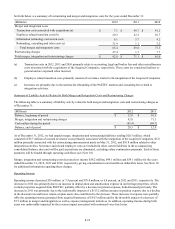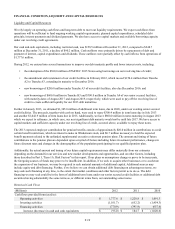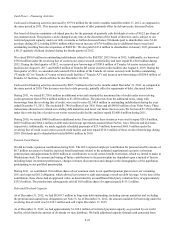Windstream 2012 Annual Report Download - page 115
Download and view the complete annual report
Please find page 115 of the 2012 Windstream annual report below. You can navigate through the pages in the report by either clicking on the pages listed below, or by using the keyword search tool below to find specific information within the annual report.
F-17
By accepting the grant funds, we agreed to certain long-term conditions. The RUS will have a retained security interest in the
assets over their economic life, which varies by grant but is up to 23 years. In the event of default of terms of the agreement,
the government could exercise the rights under its retained security interest to gain control and ownership of these assets. In
addition, in the event of a proposed change in control of Windstream, the acquiring party would need to receive approval from
the RUS prior to effectuating the proposed transaction, for which pre-approval will not be reasonably withheld.
Internet Network Regulation
On December 21, 2010, the FCC adopted new regulations covering the provision of broadband Internet access service, defined
as a retail service offered to consumer, small business and other end user customers. Broadband Internet service provides the
capability to transmit and receive data from all or substantially all Internet endpoints, but excludes dial-up Internet access
service. The new regulations, among other things:
• require all providers of broadband Internet access service to disclose network management practices, performance
characteristics, and commercial terms of service; and
• prohibit fixed broadband Internet service providers ("ISPs"), which include our subsidiaries providing broadband
services, from blocking lawful content, applications, services, or attachment of non-harmful devices, and/or engaging
in unreasonable discrimination.
The requirements will be enforced through a combination of mechanisms, including informal and formal complaint processes.
In 2011, multiple suits were filed in federal court challenging the FCC's authority to implement these rules, and no court
decision has yet been issued. The new regulations have not caused a change in our existing procedures or operations. As such,
we cannot predict at this time the impact these new regulations may have on our revenues or expenses, or whether such impact
would be material, although it appears that our existing procedures are compliant with the regulations.
State Regulation and Legislation
Local and Intrastate Rate Regulation
Most states in which our incumbent subsidiaries operate provide alternatives to traditional rate-of-return regulation for local
and intrastate services. We have elected alternative regulation for these subsidiaries in all states except New York. We continue
to evaluate alternative regulation options in New York.
State Universal Service
We recognize revenue from the receipt of state universal service funding in a limited number of states in which we operate. In
2012, we recognized $125.8 million in state USF revenue, which included approximately $88.3 million from the Texas USF.
These payments are intended to provide additional support, beyond the federal USF receipts, for the high cost of operating in
certain rural markets.
There are two high-cost programs of the Texas USF, one for large companies and another for small companies. In 2012, we
received $77.7 million from the large company program and $10.6 million from the small company program. The purpose of
the Texas USF is to assist telecommunications carriers with providing basic local telecommunications services at reasonable
rates to customers in high cost rural areas and to qualifying low-income and disabled customers. By order of the Texas PUC,
the Texas USF distributes support to eligible carriers serving areas identified as high cost, on a per-line basis. Texas USF
support payments are based on the number of actual lines in service and therefore are subject to reductions when customers
discontinue service or migrate to a competitive carrier. All service providers of telecommunications services in Texas contribute
to the Texas USF through the payment of a monthly surcharge collected from their customers.
Several states are currently conducting reviews of their universal service funds. In particular, the Texas PUC recently adopted
an order that we expect to reduce our Texas USF support by approximately $4.3 million each year over the next four years. The
Texas PUC is also considering further needs-based and rate rebalancing reforms that could adversely impact our support in
2014 and later years. We continue to work with the Texas PUC and industry members to obtain a reasonable and more
favorable outcome. We are not yet able to determine the financial impact of any additional Texas USF reform.
New Mexico, Oklahoma, and Pennsylvania are also considering reforms to their state universal service funds. We receive $8.4
million annually from the New Mexico fund, $3.4 million annually from the Oklahoma fund and $13.3 million annually from
the Pennsylvania fund. Reviews may address various aspects of the funds, including how they pertain to the basic retail rates of
























